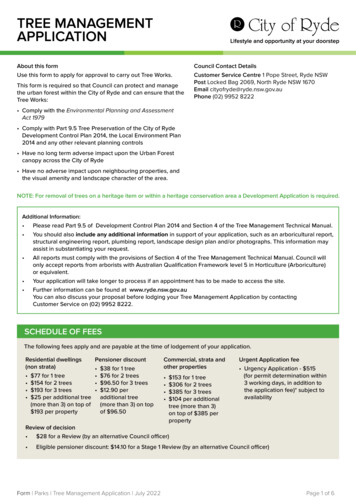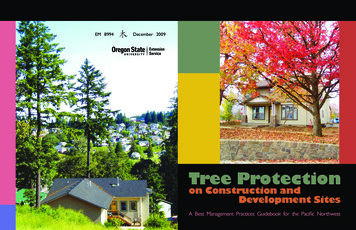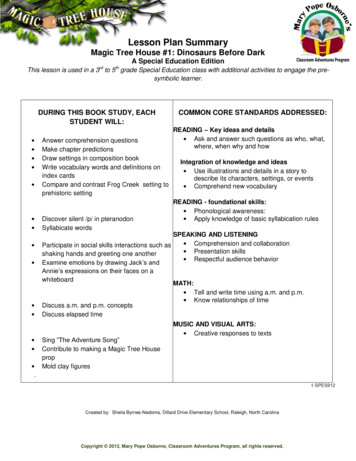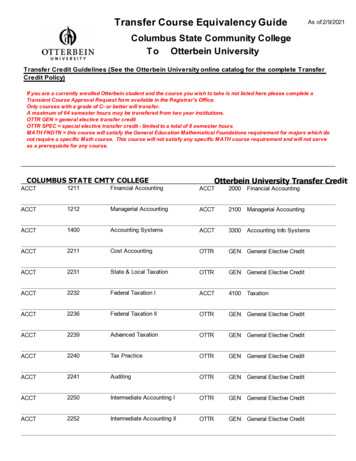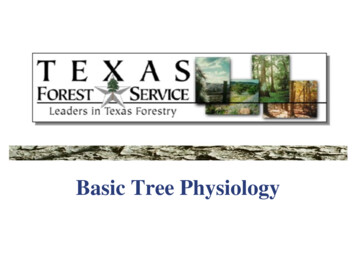
Transcription
Basic Tree Physiology
Animal and Plant Cells
Conversion of Energy
Photosynthesis Overall, water, carbondioxide, and sunlightproduce glucose and oxygen.6 CO2 6 H2O energy C6H1206 6 O2Sunlight and water createshort-term plant energy (ATPand NADH).This ATP and NADH energycreates “glucose” from CO2and RuBP.
The Anatomy of PhotosynthesisChloroplasts containingThylakoid MembranesC4 leaf with Bundle Sheathcells
C3 Photosynthesis Adaptive Value: more efficient than C4and CAM plants under cool and moistconditions and under normal light becauserequires less machinery (fewer enzymesand no specialized anatomy).
C4 Photosynthesis Adaptive Value: Photosynthesizes faster than C3 plants underhigh light intensity and high temperatures. Has better Water Use Efficiency because itdoes not need to keep stomata open as much(less water lost by transpiration).
CAM Photosynthesis Adaptive Value: Better Water Use Efficiency than C3 plantsunder arid conditions due to opening stomataat night when transpiration rates are lower(no sunlight, lower temperatures, lower windspeeds, etc.).
Respiration Sugar and oxygen produce carbon dioxide, water,and plant energy.C6H1206 6 O2 6 CO2 6 H2O energyOxygen’s main job is to bind with extraHydrogen and let the system cycle.
The Anatomy of Respiration “Glucose” is broken down by glycolysis and the citric acid cycle (mitochondria) to produce shortterm plant energy (ATP). CO2 and H20 can thenbe released or used by photosynthesis.1 glucose can produce 26 to 38 ATP.
Carbon cycling 6 CO2 6 H2O light C6H1206 6 O2C6H1206 6 O2 6 CO2 6 H2O ATPDuring good growing days, photosynthesis outperforms respiration by 40 to 70%. This allows extrasugars to be converted into the growth of wood (fixedcarbon). Thus, more O2 than CO2 is released intothe atmosphere.However, respiration occurs year round on allperennial plants. Any time a plant is not activelygrowing, it releases as much or more CO2 as O2.
Gas Exchange StomataLenticelsCollenchyma cellsRoot Absorption
Leaf FallTrees that keeptheir leaves areevergreens,trees that losetheir leaves aredeciduous.Abscission zone– area at the baseof the petiole that breaks downand causes leaf (or fruit) drop
Leaf FallDeclining intensity of sunlight triggers the processesleading up to leaf fall in gged phloem veinstrap sugars in the leafand promote productionof anthocyanins.
Tree Growth Hormones Plant growth regulators are hormones that work inconcert. auxin, cytokinins, gibberelins, ethylene, abscisicacid etc.Environmental triggers Budbreak Leaf fall Seed germination Geotropism Phototropism
Tree Needs Soil, water, sunlightMore in depth: Soil nutrients and stability,H20 runs photosynthesis and expands cells,sunlight provides energy to startphotosynthesis and signals plants.
How do trees cope?
Soil Nutrients Nitrogen, phosphorous, potassium,calcium, Magnesium, Sulphur, Iron,Manganese, Zinc, Copper, Boron,Molybdenum, and Chlorine are allconsidered essential to plant growth.
Soil Nitrogen Nitrogen makes up proteins and enzymesneeded for photosynthesis and cellsynthesis.Nitrogen deficiency results in chlorosis ofolder leaves.
Soil Phosphorus Phosphorous makes up energy transfercompounds ATP, ADP. It is also essentialin the makeup of DNA and RNA.Phosphorus deficiency often causesstunting of young trees.
Soil Potassium Potassium is essential for the movement ofwater and minerals within a plant (one ofthe main ways to manipulate osmosis). Itis also essential for protein synthesis.Potassium deficiency results in chlorosisfollowed by marginal scorching of oldleaves
How do trees cope?
Soil Gases Tree root cells perform respiration. So they takein O2 and release CO2Normal soil contains 18% O2 and 2.5% CO2.Compacted soil or clay filled areas can contain1% O2 and 20% CO2.Even just 6 inches of clay fill can decrease O2from 18% to 8%Water runoff is often increase by compaction orexcess clay fill.
How do trees cope?
Water Needs Water absorbed from the soil is needed to drivephotosynthesis as well as cell growth.Trees have growth characteristics adapted to soiltypes, water availability, and water needs of thetree species.For example, Bur Oak is known to have a tap rootwhich penetrates deep in the soil. Juniper isknown to have small roots which can search andexploit cracks in the limestone bedrock.Water is also created as a by-product ofrespiration by all living cells.
Water and Nutrient Uptake
Water Management Transpiration is the process by which water in the tree isevaporated out into the air.Each tree has it’s own unique way of dealing withtranspiration. This is an adaptation to not only the treescurrent or typically climate, but also the water needs of thetree.Juniper as juvenile can control their stomata to conservewater until their roots can find water in the bedrock. Lateras adults they lose the ability to control their stomata afterestablishing a root system and a water source.Cottonwood trees have a flattened petiole which causes theleaves to “tremble” cooling the leaf. This allows thestomata to remain open (allowing photosynthesis) during hotdry periods.
Tree Summary The leaves process waterand carbon dioxide(photosynthesis) to formsugars (fuel), which are sentback down (phloem) thetree for storage and use.The stem transports waterand nutrients up to thecrown and leafs via thexylem.The roots absorb water andnutrients with help fromroot hairs.
The End
For More InformationTexas Forest ServiceClay Bales(512) 339-7716cbales@tfs.tamu.eduTexas Forest Service Website:http://texasforestservice.tamu.edu
Tree Summary The leaves process water and carbon dioxide (photosynthesis) to form sugars (fuel), which are sent back down (phloem) the tree for storage and use. The stem transports water and nutrients up to the crown and leafs via the xylem. The roots absorb water and nutrients with help from root hairs.
